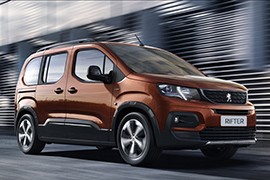PEUGEOT RIFTER Models/Series Timeline, Specifications & Photos
First production year: 2018
Engines: Gasoline, Diesel
The French carmaker had a different idea about how an MPV should look, so it made the Partner Tepee which it replaced in 2018 with the Rifter.
Europeans tried to build minivans, but the result was not that good. So, Peugeot thought about a middle ground. Instead of developing one from scratch, it made an LCV based on a passenger car platform and, afterward, turned it into an MPV.
Since the LCV market was very important in the French carmaker economy, it focused on developing a bodywork suitable for one. Thus, it made a short front end with a flat front fascia and high-mounted headlights. For the passenger version, it added as an option a plastic underbody shield that looked like an aluminum one and a pair of foglights deep inside unpainted, black clusters. Thus, the main grille was small, but the cooling area was complemented by an additional, lower grille. From its profile, the Rifter looked more like an LCV with its flat side panels and rear sliding doors. Moreover, the black door mirrors were huge compared to those installed on hatchbacks or mid-size sedans.
Inside, not even NBA players could complain about headroom. Above the windshield line, the carmaker had enough room to install a shelf for small items, an emergency kit, and the owner's manual. At the back, the ingress and egress were very easy, and passengers could've enjoyed the three-seat layout, which, when folded down or completely removed, transformed the family vehicle into a proper LCV. Last but not least, the car was available in a longer version that provided room for seven occupants.
Since the car was based on the same EMP2 platform shared with a compact hatchback and a compact crossover, it featured just small, inline-four engines paired to a standard six-speed manual gearbox. For specific versions, the carmaker added an eight-speed automatic transmission.
